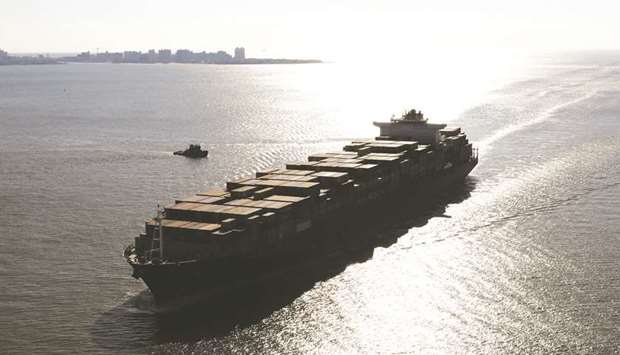How oil’s plunge might end up boosting US natural gas prices

A sharp reduction in shale oil drilling because of crude’s crash could end up boosting US natural gas prices and potentially curb an oversupply in the global market for liquefied natural gas.
Oil markets have crashed by almost a third to less than $35 a barrel after the disintegration Friday of the Opec+ alliance, which has triggered a price war between Saudi Arabia and Russia. If the plunging price discourages shale oil drilling, the knock-on effect could be a cut in the supply of gas extracted as a byproduct, according to Goldman Sachs Group Inc.
If shale producers invest on the basis of $30-$45 per barrel of crude over the next 5 quarters, there will be about 1bn cubic feet a day less US gas production, said Goldman analysts including Brian Singer. That’s about 1% of US daily natural gas output in December.
“US producers tend to respond to prices with a lag of a couple of months, though we see the response time narrowing, given flexibility of shale and greater focus on free cash flow,” the Goldman analysts said.
Front-month US gas futures fell as much as 9.8 cents, or 5.7%, to $1.610 per million British thermal units, the lowest intraday level since August 27, 1998. Prices losing just 1/10th of a cent from there would put it at the lowest since September 1995.
The US is brimming with gas as production booms. This has been particularly acute in the Permian formation, where prices for gas extracted from oil drilling have tumbled below zero, meaning producers will pay others to take the fuel off their hands. Output from the West Texas and New Mexico shale play is rising faster than pipelines can be built to carry it away.
In Europe, which has boosted imports of US LNG, front-month benchmark Dutch prices were down 3.2% Monday after earlier falling as much as 5.8%.
If European gas prices “were to drop any further, we should see a downward adjustment in LNG exports from the US to Europe as exporters of spot cargoes would not be covering their operational costs,” said Carlos Torres Diaz, head of gas and power markets at Rystad Energy AS.
The plunge in oil may turn the global gas industry on its head. Gas supply contracts linked to oil prices, which have been out of favour as gas dropped faster than oil, will probably become attractive again. “You could certainly see gas prices in the US supported by low oil prices,” said Ciaran Roe, global director of LNG at S&P Global Platts, in an interview. Last year’s view where oil linkages were frowned upon “looks to be receding into the rear-view mirror.”









BRUSSELS – The spread of the COVID-19 coronavirus across Europe and the United States has led to a sharp financial-market correction and prompted calls for active monetary and fiscal policy to prevent a recession. But a closer look suggests that such an approach might not help much at all.
The COVID-19 epidemic is marked by uncertainty. Technically, it does not represent a “black swan” event, because there have been other pandemics before. But it was, until a few months ago, unforeseeable, at least in specific terms. And it will have a long-lasting impact even if its precise evolution cannot be predicted today.
For now, it seems that the virus is moving westward. In China, where the virus emerged, infections are declining after the authorities implemented radical measures – including lockdowns that brought the economy to a standstill for over two weeks. Although it is too early to tell whether the virus has really been contained, economic life now seems to be normalizing gradually, implying that the “China shock” may be unwinding.
In the US and Europe, by contrast, the shock seems to be just beginning, with a fast-growing number of new infections raising the specter of severe economic disruption. This risk is particularly pronounced in the eurozone, which may not be able to weather a severe downturn without spiraling into crisis.
To be sure, the epidemic’s direct fiscal consequences seem manageable. Even Italy, which is currently suffering the most, could increase public spending for virus-containment measures without violating EU fiscal rules.
If these costs spiral – as seems likely, now that a quarter of the country, accounting for most industrial and financial activity, is under lockdown – the European Union should be able to offer support to Italy beyond allowing the government to run a larger deficit. Article 122.2 of the Treaty on the Functioning of the EU allows the European Council to grant financial assistance to a member state facing “severe difficulties” caused by “exceptional occurrences beyond its control.” This procedure should be activated now.
In any case, COVID-19’s trajectory suggests that it will likely spread farther, forcing other EU member states to adopt public-health measures at the expense of economic activity, particularly in important sectors such as travel and tourism. Moreover, supply chains will be impaired, not only by the temporary shutdown of the Chinese export machine, but also by disruptions within Europe. Neither interest-rate cuts nor new government expenditures would do much to offset the short-term effects of such shocks.
The more serious problems are likely to emerge from the financial system. While many firms can slash production quickly, running a business in “disaster recovery mode” still costs money, and debt still comes due. In Europe, where labor costs cannot be cut in the short run, the challenges this raises could be particularly serious.
Fortunately, most EU members have some system in place under which the government covers the wages of workers who become temporarily redundant for reasons outside of their employers’ control. These mechanisms, which would sustain personal incomes during the crisis, are the main reason why a long-lasting drop in consumption is unlikely. Once the virus is contained, European consumers will have little reason not to spend as much as before.
Yet two other possible developments could tip the eurozone into recession. The first is a sharp slowdown of global trade, which the EU has little power to counter. The second is a collapse in investment, which the EU can and should work to prevent.
The last eurozone crisis demonstrated that investment collapses when the financial system stops functioning. In market-based systems, like that of the US, this is a question of risk premia and plain access to credit, which policymakers can hardly influence. For Europe, with its bank-centric financial system, the key to weathering the COVID-19 crisis is thus to keep the banking sector healthy.
For that, a calibrated supervisory response is essential. The shift of banking supervision to the European Central Bank has led to more rigorous and selective credit policies by commercial banks. While this has reduced banking risks, applying tough lending standards at a time of severe economic stress caused by public-health measures could punish otherwise creditworthy firms that are facing temporary losses.
Italy’s government is providing direct financial support to companies directly affected by the lockdowns. But if the crisis spreads, the number of sectors that are affected (often indirectly) will increase. Governments cannot provide financial support to all of them. Banks can do much more, but only if they are willing to overlook bad financials. Supervisors should allow – and even encourage – such an approach.
A forbearance-based approach – together with the “automatic” fiscal stabilizers built into Europe’s social-security systems – would do far more to mitigate the risk of crisis than microscopic interest-rate cuts.
Additional fiscal stimulus, meanwhile, would be needed only in the unlikely event that the economic disruption is followed by a period of depressed demand. The eurozone’s fiscal rules pose no obstacle to such a policy mix, because they are flexible enough to permit temporary deficits that result from lower tax revenues, or fiscal support to sectors hit hard by exceptional circumstances. Nonetheless, the COVID-19 epidemic should serve as a reminder of the value of maintaining prudent fiscal policy during normal times. Countries with lower deficits and debts are in a much stronger position to respond to the COVID-19 shock than those, like Italy and France, that have not created fiscal space.
In the face of a severe shock, public authorities must act – and be seen acting. But, in this case, the usual macroeconomic instruments are unlikely to work. Central banks and government authorities should explain this to the public, and then focus their attention on the less glamorous work of safeguarding public health, household incomes, and the financial system.